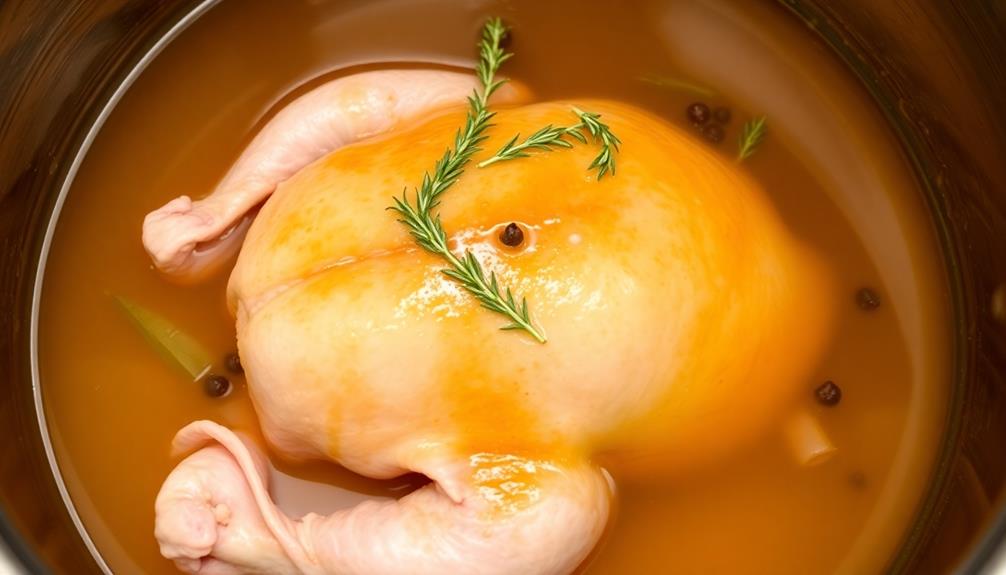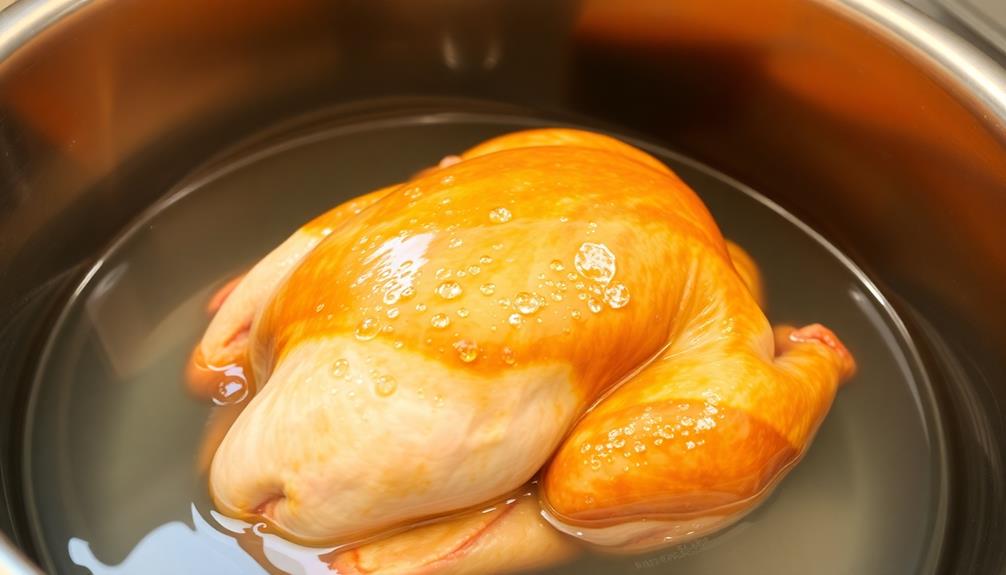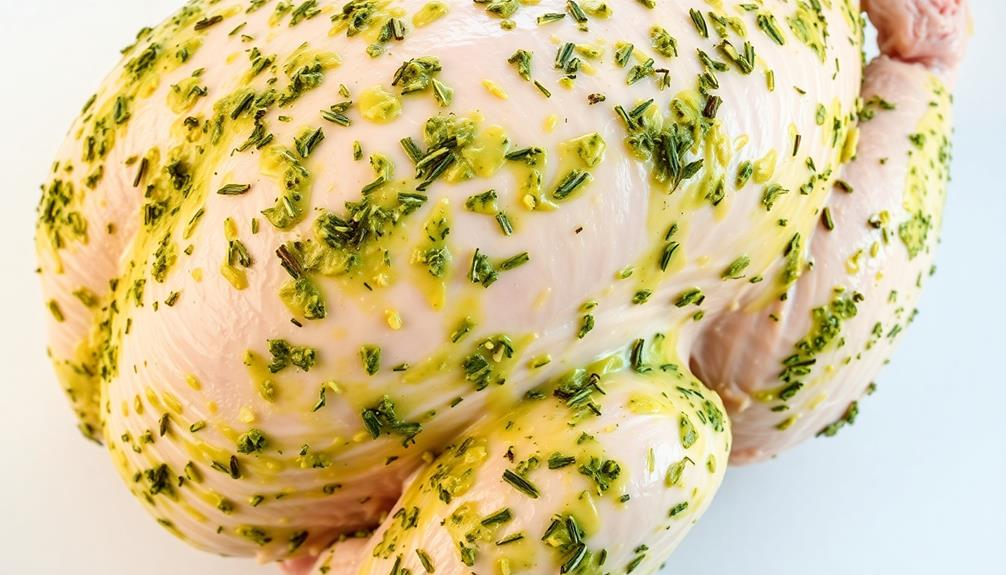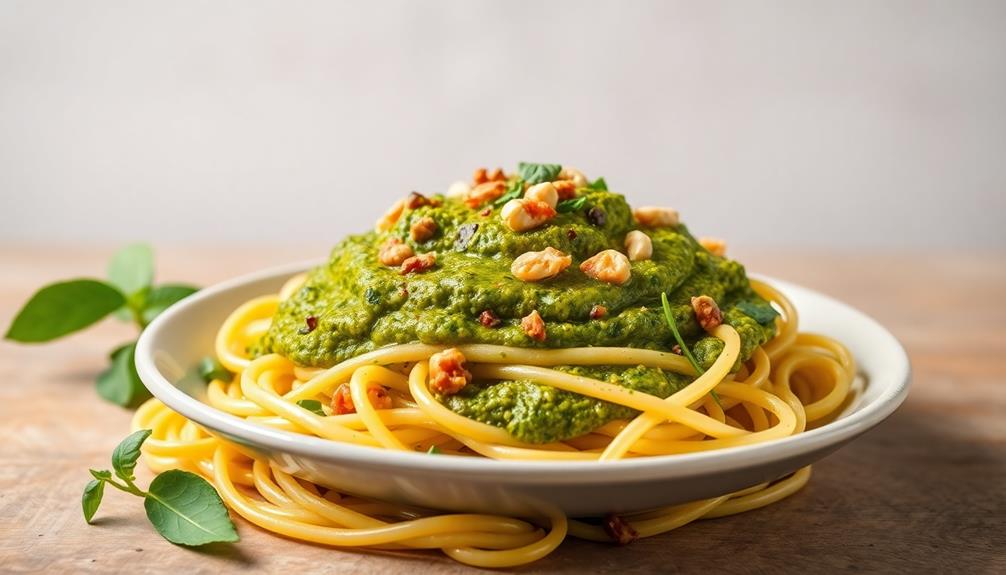Brining is the secret to transforming your Thanksgiving turkey into a mouthwatering centerpiece! It all started way back in the colonial days when folks used it to keep their turkeys juicy and flavorful. Today, brining is a recognized technique that infuses the meat with moisture and savory seasonings. You'll need to soak the turkey in a saltwater brine, then rinse and pat it dry before roasting. This tenderizes the meat and creates a crispy, golden-brown skin that'll have your guests asking for seconds. Brining is the key to a truly memorable Thanksgiving feast – and there's more where that came from!
Key Takeaways
- Brining turkey origins trace back to early American colonial period and helps keep turkey moist and flavorful for Thanksgiving.
- Essential brining ingredients include kosher salt, brown sugar, water, herbs, peppercorns, and bay leaves, with a 12-24 hour brining duration.
- Brining breaks down proteins and infuses turkey with savory seasonings, resulting in a juicy, tender, and delicious Thanksgiving centerpiece.
- Rinsing and patting dry the turkey after brining, then rubbing with herb butter, enables crispy skin during roasting for maximum flavor.
- Brining transforms a plain turkey into a mouthwatering delight, ensuring juices flow when sliced and creating a memorable Thanksgiving dining experience.
History
Tracing the origins of brining, the practice of soaking a turkey in a saltwater solution before cooking, can be found in the early American colonial period.
Back then, resourceful cooks used this technique to help keep their hard-earned birds moist and flavorful. As the years passed, the tradition of brining turkeys for Thanksgiving gained popularity, becoming a beloved part of many families' holiday celebrations.
Today, brining is a widely recognized method for preparing the perfect Thanksgiving turkey. By submerging the bird in a salty brine, the meat absorbs moisture and seasoning, resulting in a juicy, tender, and delicious centerpiece for your feast.
Whether you prefer a simple salt-and-water mixture or a more complex blend of herbs and spices, brining is a foolproof way to ensure your turkey is the star of the show.
Recipe
Brining is a crucial step in achieving a juicy and flavorful Thanksgiving turkey. The process of submerging the turkey in a salt-water solution helps to break down the proteins, resulting in a more tender and moist final product. Additionally, the brine can be infused with aromatic herbs and spices, providing a delightful depth of flavor to the bird.
Before diving into the recipe, it's important to allocate sufficient time for the brining process. Depending on the size of your turkey, the recommended brining duration can range from 12 to 24 hours. This allows the brine to fully penetrate the meat and work its magic.
- 1 (12-16 lb) whole turkey, thawed if frozen
- 1 cup kosher salt
- 1/2 cup brown sugar
- 2 gallons water
- 4 sprigs fresh thyme
- 2 sprigs fresh rosemary
- 1 tablespoon whole black peppercorns
- 3 bay leaves
In a large stockpot or clean bucket, combine the salt, brown sugar, and water, stirring until the salt and sugar have dissolved. Add the thyme, rosemary, peppercorns, and bay leaves.
Submerge the turkey, making sure it's fully covered by the brine. Cover and refrigerate for 12-24 hours, depending on the size of the turkey.
After the brining process, remove the turkey from the brine, rinse it under cold water, and pat it dry with paper towels. Proceed with your desired roasting method, ensuring the turkey is cooked to an internal temperature of 165°F.
The brined turkey will result in a juicy, flavorful, and perfectly seasoned centerpiece for your Thanksgiving feast.
Cooking Steps
Soak that turkey in a saltwater brine to lock in moisture and flavor.
After brining, rinse the bird and pat it dry.
Now, rub that turkey all over with a delicious herb butter – this'll give it a beautiful golden-brown skin when you roast it at 325°F.
Get ready for the juiciest, most flavorful Thanksgiving turkey ever!
Step 1. Soak Turkey in Saltwater Brine

With a saltwater brine, you'll infuse your turkey with exceptional moisture and flavor.
First, in a large pot or bucket, combine one gallon of water with a cup of salt. Stir until the salt fully dissolves, creating a brine.
Then, gently lower your turkey into the solution, making sure it's fully submerged. Cover and refrigerate for 12 to 24 hours, allowing the brine to work its magic.
The salt will help the turkey retain its natural juices, while also adding a delightful savory undertone.
When it's time to roast, simply remove the turkey, pat it dry, and get cooking!
Your brined bird will turn out tender, juicy, and overflowing with mouthwatering flavor in every bite.
Brining is the secret to the best Thanksgiving turkey ever – your friends and family will be amazed. First, you’ll need to create a brine by combining water, salt, sugar, herbs, and spices. Then, place your turkey in the brine and let it soak for at least 24 hours. The result? A juicy, flavorful bird that will have everyone coming back for seconds. And don’t forget to save the turkey giblets, as they can be used to make a delicious gravy or stock for soup. Understanding turkey giblets and their uses can take your Thanksgiving meal to the next level.
Step 2. Rinse Turkey After Brining

After the turkey has finished its brine, you'll want to thoroughly rinse it under cool running water. This will help remove any excess salt and brine that's still clinging to the skin.
You can even use your hands to gently rub the surface, making sure you get into all the nooks and crannies. It's important to rinse the turkey well, as any leftover brine could make the meat overly salty.
Once it's rinsed, you can pat the turkey dry with some paper towels. This will help the skin get nice and crispy when you roast it later.
Don't forget to rinse the cavity too – you want to make sure all that briny goodness is washed away.
With a clean, dry turkey, you're one step closer to the perfect Thanksgiving feast. Get ready for the juiciest, most flavorful turkey your family has ever tasted!
Step 3. Pat Turkey Dry

After thoroughly rinsing the turkey, you'll want to pat it completely dry using some clean paper towels. This is a crucial step that helps ensure the skin gets nice and crispy when you roast the bird.
Gently blot and press the paper towels against the turkey, soaking up any excess moisture. You might need to go through a few batches of towels to get the job done, but don't worry – it'll be worth it!
With the turkey nice and dry, the oven heat can work its magic, crisping up that delicious skin to golden perfection. Plus, a dry bird means the seasonings and herbs you add will stick better, infusing every bite with mouthwatering flavor.
Step 4. Rub Turkey With Herb Butter

Your next step is to create a delectable herb butter to coat the turkey. This easy-to-make mixture will infuse your bird with mouthwatering flavors!
Start by gathering a few simple ingredients – butter, fresh herbs, garlic, and a pinch of salt and pepper. In a bowl, let the butter soften at room temperature.
Then, finely chop the herbs, such as rosemary, thyme, and sage. Mince the garlic and add it to the butter, along with the chopped herbs and a sprinkle of salt and pepper.
Use a fork to mash and mix everything together until it's nice and smooth. Gently lift the skin of the turkey and spread the herb butter all over the meat, making sure to get it into every nook and cranny.
This will create a deliciously crispy and flavorful skin as your turkey roasts. With the herb butter in place, your turkey is ready for the oven!
Get ready for the amazing aroma to fill your kitchen as it bakes to perfection.
Step 5. Roast Turkey at 325°F

Preheat your oven to 325°F. This is the perfect temperature to roast your Thanksgiving turkey to perfection!
Gently place the brined turkey onto a sturdy roasting rack inside a large roasting pan. Make sure the turkey's legs are facing the front of the oven. This will help the thighs cook evenly.
Slide the pan into the preheated oven and set a timer for 2 to 2 1/2 hours. As the turkey roasts, the delicious aroma will fill your kitchen.
Baste the turkey every 30 minutes with the flavorful juices in the bottom of the pan. This will help create a beautiful, golden-brown skin.
Use a meat thermometer to check that the thickest part of the turkey breast reaches 165°F.
Once it's done, take the turkey out of the oven and let it rest for 20 minutes before carving. This allows the juices to redistribute, making your turkey extra moist and flavorful.
Now you're ready to serve up a delicious Thanksgiving feast!
Final Thoughts
Ultimately, brining your turkey is one of the best ways to ensure a juicy, flavorful Thanksgiving centerpiece. The salty brine infuses the meat with moisture and savory seasonings, transforming a plain bird into a mouthwatering delight.
Imagine slicing into that golden-brown skin and watching the juices flow – it's a moment that'll have your guests reaching for seconds (and maybe thirds!).
But the benefits of brining don't stop there. The process also helps tenderize the meat, making each bite a pleasure to chew. Additionally, brining adds flavor to the meat, ensuring that each bite is not only tender but also packed with delicious taste. Another benefit of brining is that it helps to lock in moisture, preventing the meat from drying out during the cooking process. This is where the benefits of beef broth come into play, as it can be used as a key ingredient in the brining solution to further enhance the flavor and juiciness of the meat.
And let's not forget the aromatic herbs and spices you can add to the brine, which will fill your kitchen with the tantalizing scents of the holiday season.
Frequently Asked Questions
How Long Should I Brine the Turkey for Best Results?
You should brine the turkey for 12 to 24 hours for the best results. The longer you brine, the more flavorful and moist the turkey will be. Just be sure not to brine it for too long, as it can become overly salty.
Can I Use a Dry Brine Instead of a Wet Brine?
Absolutely, you can use a dry brine instead of a wet brine. Dry brining is a simple and effective way to season and tenderize your turkey. It's a great alternative if you don't want to deal with the hassle of a wet brine.
What Type of Herbs and Spices Work Best in the Brine?
You can experiment with various herbs and spices in your brine to add flavor. Popular choices include rosemary, thyme, sage, garlic, peppercorns, and bay leaves. Use them fresh or dried, adjusting the amounts to suit your taste preferences.
How Do I Ensure the Turkey Stays Moist During Roasting?
To ensure your turkey stays moist during roasting, baste it frequently with the pan juices and consider using a meat thermometer to monitor the internal temperature. Avoid overcooking, and let the turkey rest before carving to lock in the moisture.
Can I Brine a Frozen Turkey, or Does It Need to Be Thawed?
You can brine a frozen turkey, but it'll take longer. The turkey needs to be completely thawed before brining to ensure the brine penetrates evenly. Don't try to brine a partially frozen bird – it won't work well.









